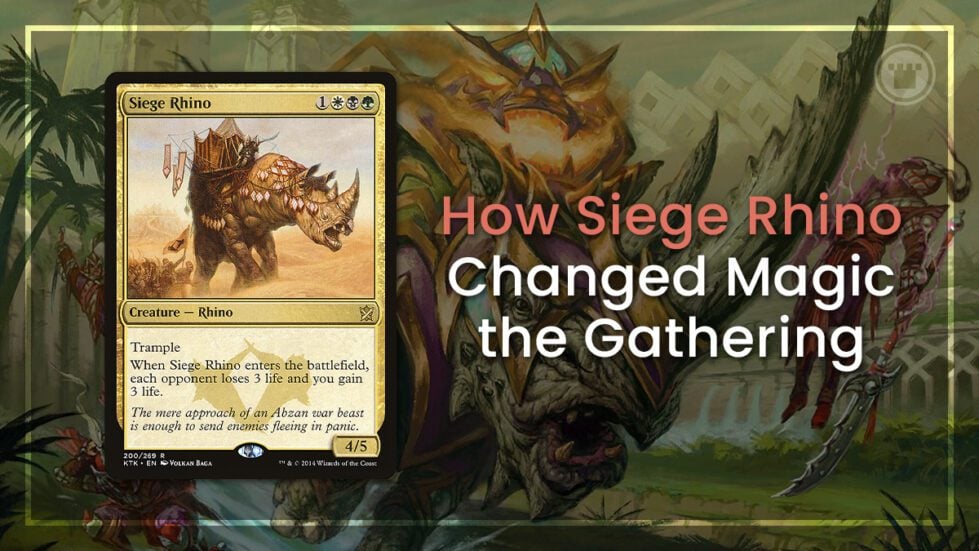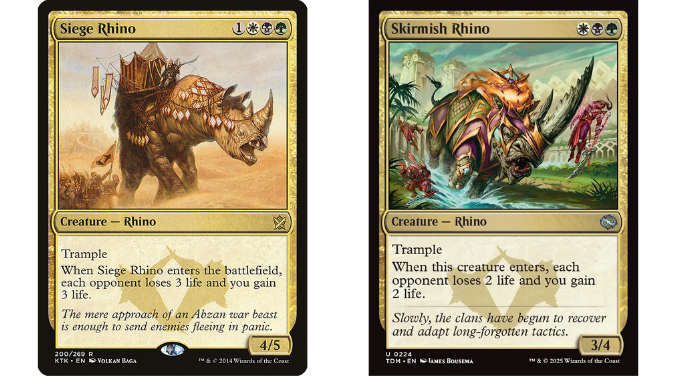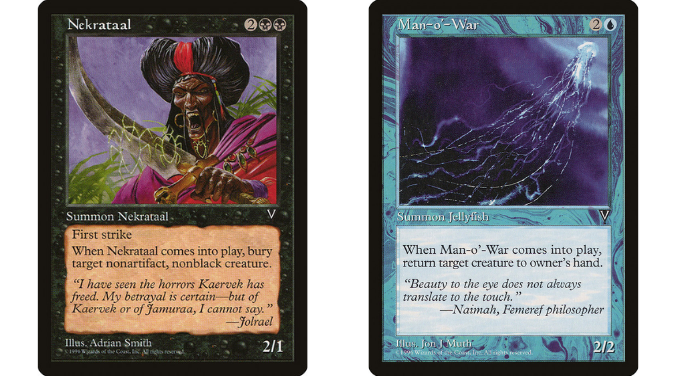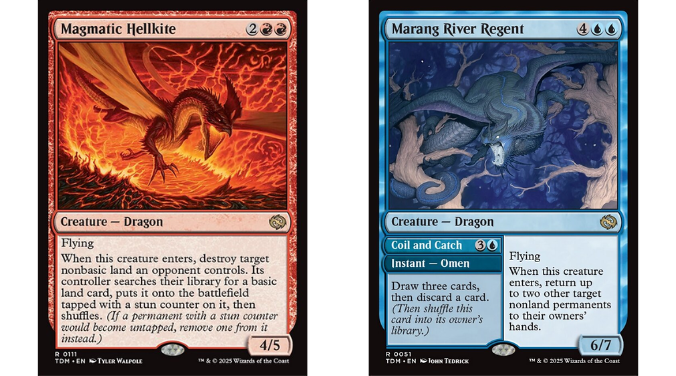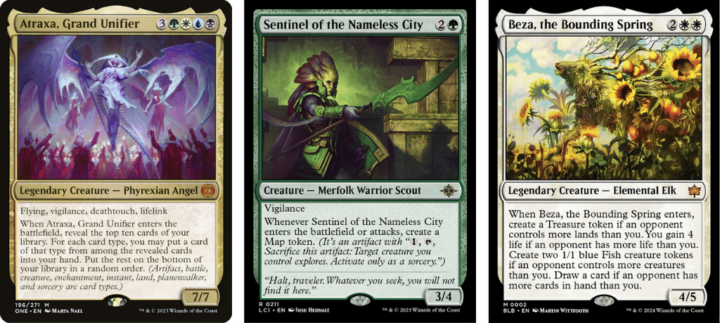Tarkir: Dragonstorm came out on April 11th, and a set that revisits an already established plane wouldn’t be complete without some references to older cards. So, it’s no surprise that we got a callback to what is arguably the most iconic card from the original Khans of Tarkir – Siege Rhino. Skirmish Rhino is a slightly smaller version of its progenitor, but it’s still an Abzan Rhino with Trample that drains life when it enters. This got me thinking about how Siege Rhino changed Magic: the Gathering design, particularly as it pertains to creatures with “enters” (formerly “enters the battlefield) triggers.
In this article I’m going to explore the history of these types of abilities with special emphasis on the place that Siege Rhino holds in that narrative.
A BRIEF HISTORY OF CREATURES WITH “ENTERS” TRIGGERS
“Enters” triggers have not always been part of Magic. In fact between 1993 and 1996, pretty much all creatures did was attack and block. This is why a creature like Serra Angel was so powerful during the game’s early days. As the first and then-only creature featuring the ability that would become Vigilance, it could attack and block. Throw in Flying and efficient stats and you have an absolute powerhouse.
However, creatures started to do something other than attack and block with the release of Visions in 1997. This is where creatures with “enters” triggers emerged. As commonplace as that type of effect is today, it was groundbreaking at the time, as it meant that creatures could have spell-like effects in addition to the usual attacking and blocking.
Of the 9 creatures with “enters” triggers in Visions, Nekrataal and Man-o’-War are probably the most notable. The former was a creature that effectively cast Terror when it entered, and the latter could effectively cast Unsummon. Suddenly, you had creatures that could add a body to the board while also subtracting from the opponent’s.
Furthermore, the fact that these creatures give you some kind of value upfront also means that removal is much worse against these creatures. If your opponent uses a card to remove them, you aren’t too upset about it because of the spell-like “enters” effect, which itself is generally worth a card. That’s one of the greatest strengths of powerful “enters” triggers. The fail-case still often has you coming out ahead.
Unsurprisingly, both of these creatures saw significant play in competitive Magic and the precedent that they set was significant. From this point on, creatures with “enters” triggers became relatively commonplace.
The next creature with an “enters” trigger to have seismic implications on competitive Magic – and the history of Magic itself – was Flametongue Kavu. Printed in 2001’s Planeshift, FTK was quickly heralded as the best creature in Standard, and for good reason. Its ability to add a hard-hitting 4/2 body to the board while also killing something with 4 or less toughness was incredible.
However, while creatures with “enters” triggers like these were making their mark on the game well before Siege Rhino ever saw the battlefield, they weren’t commonplace. Most of the game’s best creatures between 1993 and 2014 were much more one dimensional.
GOOD CREATURES BEFORE SIEGE RHINO
One only need look at the creatures that were heavily played during their respective eras to see that these creatures – like Serra Angel – earned this status largely based on their stat-lines, activated abilities, and keyword abilities. None of them came with a way to impact the board simply by entering it.
Morphling could hit really hard thanks to its ability to adjust its stats, it could play offense and defense (like Serra Angel) because it could untap, it was hard to block because it could gain flying, and it was hard to kill because it could gain shroud. You needed to have mana to do any of this stuff, too.
Masticore was an easy to cast 4-mana 4/4 that could regenerate, and it had an activated ability that could allow you to pick off small creatures. However, as with Morphling, you had to spend mana in addition to what you spent to cast Masticore for it impact the board with more than just it’s body.
Spiritmonger was an eye-popping 5-mana 6/6 who could grow when it dealt damage, and it’s ability to regenerate made it really resilient.
HOW SIEGE RHINO CHANGED THE GAME
So far, we’ve seen creatures with “enters” triggers that themselves have a big impact on the game – like Nekrataal, Man-o’-War, and Flametongue Kavu. We’ve also seen creatures with what were incredible stats for their era – like Serra Angel, Spiritmonger, and Doran.
Siege Rhino combines both of these amazing advantages into a card that was one heck of a powerhouse. For the same mana value as Flametongue Kavu, you get a colossal ⅘ trampler. And, while the Rhino’s “enters” trigger isn’t quite as good in most situations, it’s a powerful one. It goes right after the opponent’s life while gaining you life too.
This means Siege Rhino simply entering the battlefield creates a gap of 6 life between you and your opponent. So, as with the older “enters” creatures, your opponent having to spend removal on the Rhino means that they come out behind. And if they don’t remove it, it’s going to threaten their life total with its stats and evasion.
Siege Rhino became the best creature in Magic for a time, dominating multiple 60-card formats as a result of this powerful design. In fact, I left off with Doran. Siege Rhino quickly replaced the aforementioned Siege Tower in Modern Abzan decks, showcasing the fact that simply being a three mana 5/5 was no longer enough in a world of Siege Rhinos.
THE DESCENDANTS OF SIEGE RHINO
Siege Rhino also marks a movement towards more and more creatures coming with “enters” triggers. Something that has continued unabated. The original Khans of Tarkir had 18 such creatures, including Siege Rhino. Tarkir: Dragonstorm has 65, including Skirmish Rhino. That’s almost half of all the creatures in the set.
Many of these creatures also happen to be incredibly efficient for the cost, like the original Rhino is. If we just take a look at Tarkir: Dragonstorm’s creatures with powerful “enters” triggers, you’ll find that Skirmish Rhino isn’t the only creature in the set with above-rate stats and a powerful “enters” trigger.
For example, Magmatic Hellkite denies your opponents mana in addition to being a 4-mana ⅘ flyer, and Marang River Regent is a 6-mana 6/7 flyer with an enters trigger that puts Man-o’-War to shame.
And it’s not like Tarkir: Dragonstorm has a monopoly on this kind of design. We see creatures with great stats that generate immediate value with “enters” triggers in every single set, and you can find them at virtually any mana value.
The list of this type of creature is incredibly long, so I’ll limit myself to three examples that are impacting multiple 60-card formats right now – Atraxa, Grand Unifier, Sentinel of the Nameless City, and Beza, the Bounding Spring. These creatures wouldn’t be the powerhouses they are without their combination of powerful “enters” triggers and efficient stat-lines.
Creatures like these are commonplace today, and they are very much descendants of Siege Rhino – the very first creature to combine a powerful “enters” trigger with a good stat-line.
END STEP
So, what do you think? Did Siege Rhino change Magic? Do you think it was for the better? Let me know over on X or Bluesky.

Jacob has been playing Magic for the better part of 24 years, and he especially loves playing Magic’s Limited formats. He also holds a PhD in history from the University of Oklahoma. In 2015, he started his YouTube channel, “Nizzahon Magic,” where he combines his interests with many videos covering Magic’s competitive history. When he’s not playing Magic or making Magic content, he can be found teaching college-level history courses or caring for a menagerie of pets with his wife.

